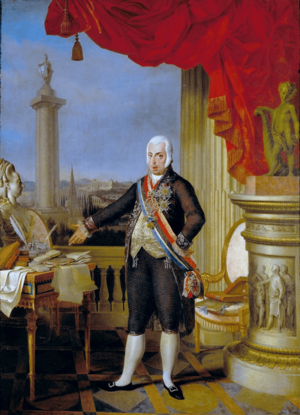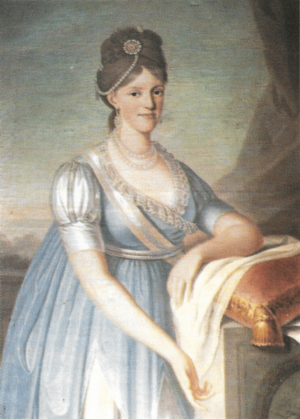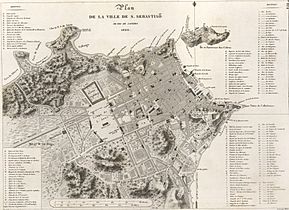Transfer of the Portuguese court to Brazil facts for kids
The Portuguese royal court, including Queen Maria I of Portugal, Prince Regent John, and the royal family, moved from Lisbon, Portugal, to the Portuguese colony of Brazil on November 27, 1807. This was an important move to protect them from Napoleon's army, which invaded Portugal just days later. About 10,000 people, including the royal family and many officials, made the journey. The ships left on November 29 due to bad weather.
The Portuguese crown stayed in Brazil for 13 years, from 1808 until 1821. During this time, Rio de Janeiro, Brazil, became the capital of the Kingdom of Portugal. This was unusual because a colony was now governing an entire empire. The royal court's time in Rio brought many big changes to the city and to Brazil. It greatly affected Brazilian society, economy, buildings, and politics. This move was also the first step toward Brazil becoming independent. The king quickly opened Brazil's ports to trade with other countries and made the colonial capital the center of government.
Contents
How the Royal Family Moved to Brazil
In 1807, a war in Europe called the Peninsular War was happening. Napoleon's army attacked Portugal because Portugal was friends with Great Britain. At that time, Prince John was ruling Portugal for his mother, Queen Maria I, who was not well enough to govern. Knowing Napoleon's army was coming, Prince John decided to move the royal court to Brazil so he wouldn't be removed from power.

The royal group sailed for Brazil on November 29, protected by the British Navy and the Portuguese Navy. A large fleet of ships, including eight big warships, escorted them. On December 5, part of the British fleet returned to Europe, but British officer Graham Moore continued to escort the Portuguese royal family to Brazil with several British ships.
Big Changes in Brazil
On January 22, 1808, Prince John and his court arrived in Salvador, Brazil. There, Prince John signed a law called "Abertura dos Portos." This law opened Brazil's ports for trade with "friendly nations." This was very good for Great Britain, who had helped the royal family. This new law also broke the old rule that Brazil could only trade with Portugal. This changed Brazil's economy, its people, and its way of life. Secret talks in London in 1807 had already promised British military help in exchange for Britain being able to use Brazil's ports.
Later in 1808, Prince John signed another law, the "Alvará de Liberdade para as Indústrias." This law allowed factories to be built in Brazil. Before this, Brazil was mainly an agricultural producer, meaning it only grew crops. This new law meant Brazil could now make its own goods. Prince John wanted to make the country richer and create more jobs. He removed all rules that stopped industries from growing. This also increased the need for workers and brought money from other countries.
Rio de Janeiro's Growth
When the Portuguese court arrived in Rio de Janeiro on March 7, 1808, Brazil did not have many people, only a little over 3 million. About one-third of the people were enslaved, mostly brought from Africa. The native population was around 800,000, much smaller than before colonization. Most people lived along the coast. Rio de Janeiro was already growing fast around 1800. Its population had grown ten times in the 1700s because gold and diamonds were found. Also, about 2 million enslaved Africans were brought to Brazil to work in mines and sugar farms.
Most Brazilians at the time could not read or write, were poor, and lacked basic services like medical care. Only 2.5% of free men could read. The city became very crowded, and people were unhappy. The old colonial government was not enough to handle these changes.

Between 1808 and 1821, Prince John (who became king in 1816) gave out 145 titles of nobility. This was more than the Portuguese royal family had given in the past 300 years in Portugal! Many of these titles went to people who had traveled with the court or fought the French. British people also received titles to thank them for their help. These titles helped the royal family keep power in Brazil. When Prince John made Brazil a co-kingdom with Portugal in 1815, the number of titles given out increased a lot.
Rio became a very important center for world trade and grew hugely. The monarchy preferred Portuguese people for government jobs. With new government offices and military groups, almost all officials were Portuguese.
Who Got Noble Titles?
Out of 145 noble titles, only six went to Brazilians. Brazilians usually received the lowest title, "baron." To keep Brazilians happy, they were also given land and positions in the treasury council. These were ways to keep them content without giving them too much power compared to the Portuguese high society. The first noble title for a Brazilian was given in 1812. Many titles were given in 1818, when Prince John officially became king. These titles did not help Brazilians much and did not create strong ties between Brazilians and the new nobility. It seemed that noble titles were mainly for Europeans to keep their power in Brazil. By giving titles to Portuguese people, the court made sure it had financial support to live far from Portugal.
Slavery and Social Changes
The changes in Brazil also meant a greater need for enslaved labor. With the end of the old trade rules, the coffee and sugar industries grew. New industries like shipbuilding and steel also started. The number of enslaved people arriving in Brazil increased greatly during and after the court's stay. About 328,000 enslaved people arrived in Brazil during this time. This changed the population of Brazil, especially Rio, where most of them arrived. At one point, enslaved people made up more than half of Rio's population.
After a successful slave revolt in Haiti, the court worried about possible rebellions in Brazil. This led to the creation of the Royal Police Guard. This new police force was in charge of keeping order in the city. This made life harder for enslaved people and was the start of a problem that continued for many years: linking poverty with crime. It also made racial discrimination official.
The arrival of the royal family also made the social classes even more separate. Those who were already rich became richer, and the poor became even poorer. They had to compete for resources and services. With the Portuguese government in Brazil, more Portuguese people moved there. This made the local people of Rio (called Cariocas) unhappy. The court wanted to seem open to hearing people's concerns, but only a few chosen people could meet Prince John. He started a daily ceremony called beija-mão, where people could kiss his hand and share their problems. However, mainly rich white men, nobles, and religious leaders used this to push their own ideas.
On December 16, 1815, Prince John created the United Kingdom of Portugal, Brazil and the Algarves. This made Brazil equal in rank to Portugal and gave it more independence. Brazilian representatives were even elected to the Portuguese courts. This happened after Napoleon's defeat, when European leaders met to reorganize Europe. Portugal wanted to have more power in these talks. In 1816, after Queen Maria died, Prince John became king of this new United Kingdom. His crowning ceremony took place in Rio de Janeiro in 1818.
Building a New Capital
Rio de Janeiro needed to expand its buildings and services to fit the 15,000 new people. The city lacked basic sanitation and proper sewer systems. There were also very few roads. The goal was to build a "perfect city" that showed the power and goodness of the royal family and government. The city needed to reflect the growing empire. So, public libraries, botanical gardens, opera houses, palaces, and government buildings were built. Rio was meant to be modern and safe.
Before the royal family arrived, Brazil's cities were very separate. Huge areas of empty land and thick forests divided cities like Rio de Janeiro, São Paulo, and Salvador. To control the country better, the government worked to connect city centers by building roads. The monarchy also encouraged trade within Brazil. The old Portuguese Empire had kept cities separate to prevent Brazilians from organizing against the crown. But now, with the government directly in Brazil, this was no longer useful. All these building projects were done with the hard work and lives of enslaved people. It is thought that Rio's enslaved population grew by 200% between 1808 and 1822. This meant that making Rio a royal capital also involved dealing with slavery and the large number of African and Afro-Brazilian residents. Slavery was not legal in Portugal but was allowed in Brazil and continued for many years even after Brazil became independent.
Steps Towards Independence
King John VI took important steps to make Brazil more like Europe. He encouraged trade and industry, allowed newspapers and books to be printed (though the first printing press, Imprensa Régia, was controlled by the government), and started two medical schools and military academies. He also created the first Bank of Brazil (Banco do Brasil). In Rio de Janeiro, he set up a powder factory, a botanical garden, an art academy, and an opera house. All these actions helped Brazil move closer to independence from Portugal. However, the crown also continued the African slave trade, attacked native peoples, and gave land to royal favorites. He also tried to stop ideas of political independence from the United States and other former Spanish colonies from spreading. Britain's influence in Brazil grew, with good trade deals and special rights for British merchants.
Because the king was away and Brazil was becoming more economically independent, Portugal faced a serious political crisis. This forced King John VI and the royal family to return to Portugal on April 25, 1821. If he didn't go back, he risked losing his Portuguese throne. King John VI's son, Pedro I, stayed in Brazil. The Portuguese government demanded that Brazil return to being a colony and that Pedro return to Portugal. But Prince Pedro, influenced by the Rio de Janeiro city council, refused to go back on January 9, 1822, a day known as Dia do Fico (Day of I Stay). Brazil declared its independence on September 7, 1822, forming the Empire of Brazil. This ended 322 years of Portugal's rule over Brazil. Pedro was crowned the first emperor in Rio de Janeiro on October 12, 1822, becoming Dom Pedro I.
What Happened Next
The Portuguese court's time in Rio de Janeiro created the conditions that led to Brazil's independence. With the court's arrival, Rio de Janeiro's population grew quickly. This, along with more trade and immigration, made the city a major economic center. In 1815, Brazil was declared a co-kingdom with Portugal, changing its status from a colony. This showed Brazil's growing independence, which continued to grow after the royal family returned to Europe a year later.
The move of the Portuguese nobility to Brazil in 1808 had huge effects. It started and changed Brazilian politics, altered society and population, developed the economy, and physically changed Rio de Janeiro. Different groups of people, like the nobility, rich families, Brazilians, native peoples, and enslaved Africans, felt these impacts in different ways.
Brazil became independent without the violence seen in other nearby countries. This was partly because its new independent identity affected Pedro, King John's oldest son and Brazil's first emperor. Pedro was nine years old when his family left Portugal, so he grew up in Rio de Janeiro. Growing up in Brazil made Pedro feel like a Brazilian, which influenced his decision to defy Portugal in 1821. Because he was the heir to the Portuguese crown, Pedro could stop Portugal from trying to take Brazil back. The smooth transition to independence, along with economic and cultural progress, led to a successful time for the young nation. During the royal court's stay and Brazil's early independence, many immigrants and enslaved people arrived. The immigrants were mostly young Portuguese who chose to stay in Brazil. This also happened during a time of political trouble in Portugal, where losing Brazil caused many revolts. The immigrants staying showed the new economic chances in independent Brazil. However, there was also strong anti-Portuguese feeling among the people of Rio, showing their lasting unhappiness with their former rulers.
See Also
- Free French Africa, a similar move of a government to a colony to escape occupation.
- Timeline of the Peninsular War
- Secret Convention on the Transfer of the Portuguese monarchy to Brazil
|



